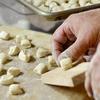
Mint Tea
In cooking terms, infusing is the simple chemical process by which a liquid is permeated with the flavor of another ingredient, usually botanic components like herbs, berries, fruit or even flowers. The botanicals release their natural oils and essence in water, vinegar, oil or alcohol.The liquid to be infused is typically boiled and then poured over the botanic, which is then allowed to steep in the liquid for a period of time. The liquid is then strained (or the herbs otherwise removed from the liquid) before use. A common example of an infusion is tea; lemon, chamomile, ginger and a great many other plants are used in infusions with water to create herbal remedies.

Bacon Bourbon
Plants with desirable flavors can also be steeped in olive oil or vinegar and used to add flavor to salads or used in cooking. Fruits and herbs can be steeped in alcohol to create delicious infusions for use in specialty cocktails. One popular alcohol infusion involves soaking crisped bacon in bourbon to create “Bacon Bourbon.”Sugar can be infused with natural flavors as well. Sugar can be easily infused with vanilla by simply adding a vanilla bean to a jar of sugar and allowing it to sit until the sugar absorbs the aroma and flavor of the vanilla bean. Vanilla sugar is a delightful accompaniment to fresh fruit, coffee drinks and herbal tea infusions.

Sun-dried citrus salt and peels
Salt is another good candidate for infusion. We infuse salt with citrus by peeling the zest from lemons, limes and or oranges and adding it to kosher salt. We place the salt and peels in the refrigerator for 2 days and then lay the salt and zest on a parchment lined baking sheet and allow the salt and peels to dry in the sun. The salt is then ready to use to add “brightness” to salads and seafood dishes or rim margarita glasses. The salted zest can be used as a substitute for preserved lemons or in recipes calling for citrus zest (reducing the salt in the recipe by a bit.)
